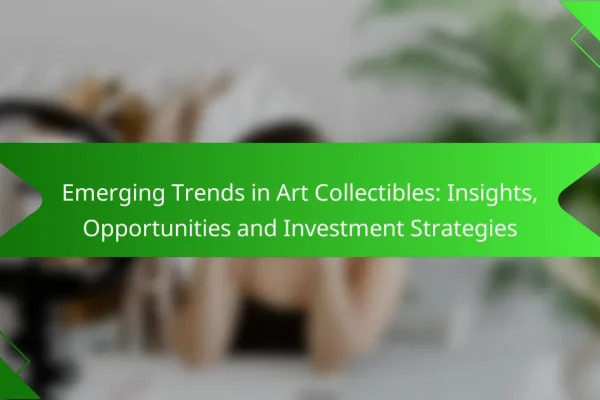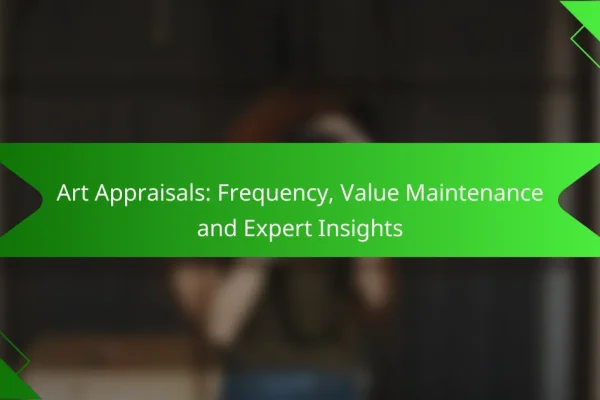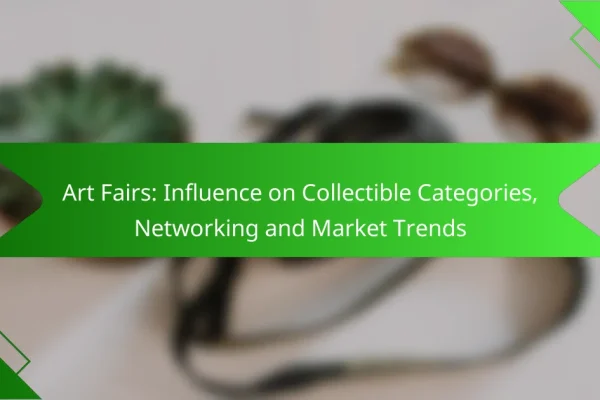
Market Trends in Art Investment: Insights, Predictions and Opportunities
The art investment landscape is evolving, with notable trends highlighting a shift towards digital mediums…
Starting an art collection can be an enriching experience, but it requires careful consideration of your preferences and budget. By exploring local galleries, art fairs, and collector groups, you can enhance your knowledge and network within the art community. Key factors such as authenticity, artist reputation, and market trends are essential for making informed decisions and building a valuable collection.

The art investment landscape is evolving, with notable trends highlighting a shift towards digital mediums and increased involvement from investment funds. As the acceptance of art as a legitimate asset class grows, innovations such as blockchain technology are enhancing transparency and accessibility, making it easier for both seasoned and new investors to engage with the…

The landscape of art collectibles is rapidly evolving, influenced by technological advancements and a growing emphasis on sustainability. As collectors increasingly gravitate towards digital formats and immersive experiences, new investment opportunities emerge, necessitating a keen understanding of market trends and community engagement. However, potential investors must also navigate risks such as market volatility and authenticity…

Digital art collectibles represent a transformative shift in the art world, distinguishing themselves from traditional art forms through unique ownership and distribution methods enabled by blockchain technology. As the market for these digital assets continues to expand, driven by technological advancements and a burgeoning community of artists and collectors, they offer unique investment opportunities that…

Art appraisals are crucial for maintaining the value of collections, typically recommended annually for insurance and every 3-5 years for market updates. Regular evaluations help ensure that artworks retain or increase their market value, while expert appraisers provide essential insights and accurate assessments for collectors and institutions alike. How often should art appraisals be conducted…

Diverse artists play a crucial role in enriching the arts landscape by introducing a multitude of perspectives and experiences that enhance creativity and innovation. However, they often face significant barriers, such as limited access to resources and systemic biases, which can impede their success. To address these challenges, organizations must actively promote inclusion and representation,…

Art collecting groups serve as a vital resource for local networking, bringing together collectors, artists, and enthusiasts to foster meaningful connections. By participating in these groups, members gain access to exclusive events, valuable insights, and collaborative opportunities that enhance their art collecting journey. How can art collecting groups enhance local networking? Art collecting groups can…

Art mediums play a crucial role in shaping the creative landscape, offering a variety of techniques that enable artists to express their visions. From traditional forms like painting and sculpture to contemporary digital art and mixed media, each medium presents unique opportunities and challenges. The choice of medium not only influences the aesthetic outcome but…

Art fairs play a crucial role in shaping collectible categories by showcasing both emerging artists and established works, allowing collectors to explore new trends and assess market interest. These events foster valuable networking opportunities among collectors, artists, and galleries, leading to collaborations and exclusive access to artworks. Additionally, current market trends at art fairs highlight…

Art preservation is essential for maintaining the integrity and longevity of artworks, employing techniques such as temperature control, light management, and preventive conservation strategies. A critical aspect of this process is humidity control, which helps prevent damage like mold growth and material deterioration. Additionally, specialized materials, including archival quality papers and conservation-grade adhesives, play a…

Art framing is essential not only for enhancing the visual appeal of artwork but also for ensuring its protection and longevity. Various methods, such as traditional framing and shadow box framing, offer distinct advantages that cater to different artistic needs. Additionally, effective display techniques, including thoughtful arrangement and appropriate lighting, can significantly elevate the overall…
Starting an art collection in the UK involves understanding your preferences, setting a budget, and exploring various avenues to acquire artworks. Focus on local galleries, art fairs, and collector groups to build your knowledge and network.
Local galleries are essential for discovering emerging artists and unique pieces. Visit galleries in your area to familiarize yourself with different styles and mediums, and take note of artists whose work resonates with you.
Many galleries offer exhibitions and events that provide insights into the art market. Engaging with gallery owners and curators can also help you understand pricing and the value of artworks.
Art fairs are excellent opportunities to see a wide range of artworks from various artists and galleries in one place. These events often feature established and emerging talents, allowing you to compare styles and prices easily.
When attending art fairs, prepare to ask questions and take notes. This can help you gauge the market and identify pieces that fit your collection. Be mindful of your budget and consider setting a spending limit before you go.
Joining art collector groups can provide valuable networking opportunities and insights into the art world. These groups often host events, discussions, and exhibitions that can enhance your understanding of art collecting.
Participating in these communities can also help you connect with other collectors who share your interests. They can offer advice on purchasing, selling, and maintaining your collection, as well as share information about upcoming events and exhibitions.
When collecting art, key factors include budget allocation, art authenticity, and artist reputation. Understanding these elements can help you make informed decisions and build a valuable collection.
Establishing a budget is crucial before starting your art collection. Determine how much you are willing to spend overall and allocate funds for individual pieces, taking into account additional costs like framing, insurance, and maintenance.
Consider setting a range for each artwork, which can vary widely based on the medium, artist, and market demand. For example, emerging artists may offer pieces in the low hundreds to low thousands of USD, while established artists can command prices in the tens of thousands or more.
Ensuring the authenticity of art is vital to protect your investment. Always seek documentation, such as certificates of authenticity or provenance records, which provide a history of the artwork and verify its legitimacy.
Be cautious of forgeries, especially in high-value markets. Engaging with reputable galleries or auction houses can help mitigate risks, as they often have established processes for verifying authenticity.
The reputation of an artist can significantly influence the value of their work. Research the artist's background, previous exhibitions, and sales history to gauge their standing in the art community.
Consider investing in works by artists who have shown consistent growth in recognition and demand. Emerging artists may offer lower prices, but their potential for future appreciation can be substantial if they gain prominence.
To evaluate the value of an artwork, consider factors such as market trends, provenance history, and condition reports. These elements help determine both the monetary worth and the cultural significance of the piece.
Market trends reflect the current demand and pricing for specific types of art. Changes in popularity can significantly affect an artwork's value, with contemporary pieces often experiencing rapid fluctuations compared to classical works.
Monitoring auction results, gallery sales, and online platforms can provide insights into which artists or styles are gaining traction. For instance, works by emerging artists may sell for lower amounts initially but can appreciate quickly if they gain recognition.
Provenance history refers to the documented ownership of an artwork, which can greatly influence its value. A well-documented provenance can enhance an artwork's desirability, especially if it has been owned by notable collectors or displayed in prestigious exhibitions.
When evaluating provenance, consider factors such as the artwork's exhibition history, previous sales, and any relevant documentation. A piece with a clear and reputable lineage is often valued higher than one with an unclear history.
Condition reports assess the physical state of an artwork, detailing any damage or restoration work. The condition can significantly impact value, as pieces in excellent condition typically command higher prices than those with visible wear or damage.
When evaluating an artwork, obtain a professional condition report to understand its current state. Look for issues like fading, cracks, or repairs, and factor these into your valuation. Regular maintenance and proper storage can help preserve an artwork's condition over time.
Best practices for art preservation include maintaining proper lighting, controlling the climate, and conducting regular maintenance. These practices help ensure the longevity and integrity of artworks, protecting them from damage caused by environmental factors.
Proper lighting is crucial for art preservation as it can prevent fading and deterioration. Use UV-filtered lights and avoid direct sunlight exposure, which can cause significant damage over time. Aim for ambient lighting levels that are low to moderate, typically between 50 to 200 lux, depending on the type of artwork.
Consider using LED lights, as they produce less heat and UV radiation compared to traditional bulbs. Regularly assess the lighting conditions to ensure they remain within safe limits for your specific art pieces.
Climate control is essential for preserving artworks, as temperature and humidity fluctuations can lead to damage. Ideally, maintain a stable temperature between 18-22°C (64-72°F) and humidity levels around 40-60%. This range helps prevent mold growth and material degradation.
Invest in a reliable HVAC system and use dehumidifiers or humidifiers as needed. Regularly monitor the environment with hygrometers and thermometers to ensure conditions remain optimal for preservation.
Regular maintenance of art pieces is vital for their longevity. This includes dusting, cleaning, and inspecting artworks for signs of damage. Use soft, lint-free cloths for dusting and avoid harsh chemicals that could harm the surface.
Establish a maintenance schedule based on the type of artwork and its specific needs. For example, paintings may require more frequent checks than sculptures. Document any maintenance performed to track the condition and care of each piece.
Insuring an art collection involves assessing its value and selecting the right coverage to protect against loss or damage. It's essential to work with professionals who understand the nuances of art insurance to ensure comprehensive protection.
Engaging with insurance specialists who focus on art collections is crucial. They can provide tailored advice based on the specific types of artwork you own, whether it be contemporary pieces or historical artifacts.
Look for agents who have experience in the art market and can help navigate the complexities of insuring high-value items. They will understand the unique risks associated with art, such as theft, fire, and environmental damage.
Accurate documentation of appraisals is vital for insuring an art collection. Regular appraisals help establish the current market value of your pieces, which is necessary for determining the appropriate coverage amount.
Consider obtaining appraisals from certified professionals who specialize in art. Keep records of these appraisals, as they can be crucial in the event of a claim, ensuring you receive adequate compensation for any loss.
Art insurance policies can vary significantly, so it's important to understand the different options available. Policies may cover loss, theft, damage, and even restoration costs, but the specifics can differ widely.
Review the terms carefully, focusing on exclusions and limitations. For instance, some policies may not cover certain types of damage or may have specific conditions for high-value items. Compare multiple quotes to find the best coverage that suits your collection's needs.
Emerging trends in art collecting include the rise of digital art and non-fungible tokens (NFTs), as well as a growing focus on sustainability and diversity in art. Collectors are increasingly looking for innovative ways to invest in and showcase their collections, often blending traditional and contemporary methods.
Digital art and NFTs represent a significant shift in the art market, allowing artists to create and sell works in entirely new formats. NFTs are unique digital assets verified using blockchain technology, which ensures ownership and provenance. This has opened up new opportunities for both artists and collectors.
When considering digital art and NFTs, collectors should evaluate the platform used for purchase, the artist's reputation, and the rarity of the piece. Prices for NFTs can vary widely, often ranging from a few hundred to millions of dollars, depending on the artist and market demand.
Collectors should be cautious of potential pitfalls, such as market volatility and the risk of scams. It's advisable to conduct thorough research and only invest in well-established platforms. Additionally, keeping abreast of technological advancements and trends in the digital art space can help collectors make informed decisions.